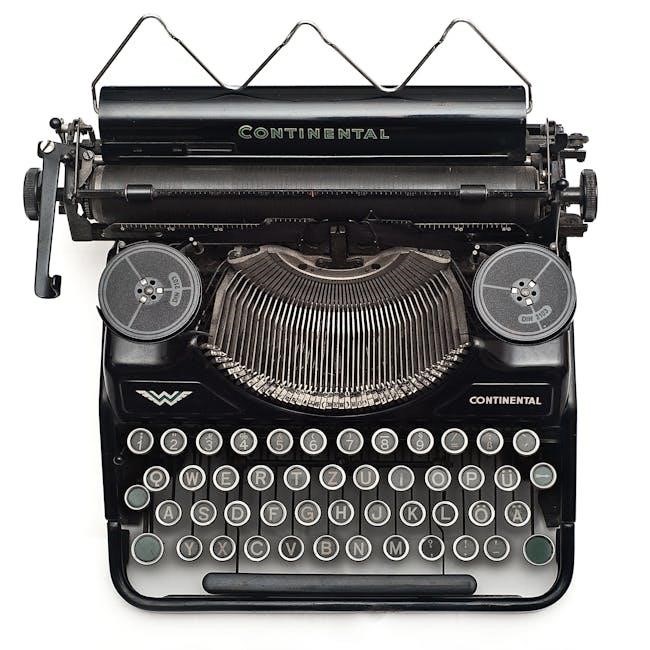This manual provides comprehensive guidance for setting up and operating the Canon PIXMA TS3522 printer‚ ensuring optimal performance and troubleshooting common issues effectively.
Overview of the Printer and Its Features
The Canon PIXMA TS3522 is a versatile all-in-one printer designed for home use‚ offering wireless printing and compatibility with mobile devices via the Canon PRINT app. It supports various paper sizes‚ including plain and photo paper‚ and features a compact design for convenient placement. The printer is user-friendly‚ making it ideal for printing documents‚ photos‚ and specialized materials with ease and efficiency.
Importance of Reading the Manual for Optimal Use
Reading the Canon PIXMA TS3522 manual is essential for understanding its features‚ setup‚ and maintenance. It provides detailed guidance on troubleshooting common issues‚ optimizing print quality‚ and utilizing advanced functions. By following the manual‚ users can avoid errors‚ ensure proper installation‚ and extend the printer’s lifespan. It also helps in exploring wireless printing‚ mobile device compatibility‚ and specialized document handling‚ making it a vital resource for maximizing the printer’s performance and efficiency.

Setting Up the Canon PIXMA TS3522 Printer
Unbox and prepare the printer by removing packaging materials‚ then connect the power cord and press the ON button to begin the setup and operation process;
Unboxing and Initial Setup Steps
Start by carefully unboxing the Canon PIXMA TS3522 printer and removing all packaging materials. Open the printer cover and remove the orange tape from the sides. Close the cover and connect the power cord. Press the ON button to power up the printer. Ensure all components‚ including ink cartridges and paper trays‚ are properly installed before proceeding to the next setup steps for optimal functionality.
Connecting the Printer to a Computer or Smartphone
To connect the Canon PIXMA TS3522‚ visit the Canon website and download the appropriate drivers and software for your device. Install the Canon IJ Printer Assistant Tool‚ which guides you through the wireless setup process. Ensure the printer is turned on and follow the tool’s instructions to establish a connection. The printer also supports direct mobile printing via the Canon PRINT app‚ enabling seamless wireless functionality for both computers and smartphones.
Key Features of the Canon PIXMA TS3522
The Canon PIXMA TS3522 offers wireless printing‚ mobile device compatibility via the Canon PRINT app‚ and supports various paper sizes like A4 and LTR for versatile printing needs.
Wireless Printing and Mobile Device Compatibility
The Canon PIXMA TS3522 supports wireless printing‚ enabling seamless connectivity to smartphones and tablets via the Canon PRINT app. Users can print photos and documents directly from mobile devices‚ ensuring convenience and flexibility. The printer also supports Apple AirPrint and Google Cloud Print‚ making it compatible with various mobile operating systems. This feature enhances productivity and simplifies printing without the need for cables.
Supported Paper Sizes and Types
The Canon PIXMA TS3522 accommodates a variety of paper sizes‚ including A4‚ Letter‚ and photo sizes like 4×6 inches. It supports different paper types‚ such as plain‚ glossy‚ and matte. The printer is compatible with Canon’s specialized media for high-quality photo printing. The rear paper tray holds up to 60 sheets‚ allowing for efficient printing sessions. This versatility ensures compatibility with diverse printing needs‚ from standard documents to professional-grade photos.
Downloading and Installing the Printer Manual
Access the official Canon website at ij.start.canon to download the PIXMA TS3522 manual. The PDF guide is available for free and provides detailed setup instructions.
Where to Find the Official Canon PIXMA TS3522 Manual
The official Canon PIXMA TS3522 manual can be found on Canon’s website at ij.start.canon. Additionally‚ trusted third-party sites like manuals.plus offer free PDF downloads. Visit the Canon support page‚ select your printer model‚ and download the manual for detailed setup and usage instructions. Ensure to verify the source for authenticity to avoid unauthorized downloads.
How to Access the Manual Online
To access the Canon PIXMA TS3522 manual online‚ visit the official Canon website at ij.start.canon. Navigate to the support section‚ enter your printer model in the search bar‚ and select the appropriate option. Click on the “Manuals” tab to download the PDF version. Ensure you verify the source for authenticity to avoid downloading incorrect or unauthorized documents. This ensures you have accurate and reliable guidance for your printer.

Maintaining the Canon PIXMA TS3522 Printer
Regular maintenance ensures optimal performance. Clean the print head‚ check ink levels‚ and align the printer head for consistent results and to prevent potential issues.
Regular Cleaning and Maintenance Tips
Regular cleaning and maintenance are essential for optimal performance. Turn off the printer‚ clean the exterior with a soft cloth‚ and check for dust or debris inside. Use the Canon IJ Printer Assistant Tool to access maintenance options like print head cleaning and alignment. Ensure paper trays are free from obstructions and align the print head periodically for crisp prints. Refer to the manual for detailed steps to keep your printer in top condition and prevent common issues.
How to Align the Print Head for Best Results
Aligning the print head ensures sharp and precise prints. Turn on the printer‚ then open the Canon IJ Printer Assistant Tool. Navigate to the Maintenance section and select “Print Head Alignment.” Follow the on-screen instructions to print an alignment sheet. Scan the sheet to complete the process‚ ensuring optimal print quality and color accuracy. Regular alignment is recommended after replacing ink cartridges or if misalignment occurs.

Troubleshooting Common Issues
Identify and resolve common errors using the Canon IJ Printer Assistant Tool. Check error codes‚ restart the printer‚ and ensure proper connections for smooth operation.
Resolving Common Errors and Error Codes
Common issues with the Canon PIXMA TS3522 include error codes like “E” for paper jams or low ink. To resolve these‚ turn the printer off and on‚ check paper loading‚ and ensure proper ink cartridge installation. Use the Canon IJ Printer Assistant Tool to diagnose and fix problems. For specific error codes‚ refer to the official manual or Canon’s support website for detailed troubleshooting guides and firmware updates to ensure optimal performance.
Updating Firmware for Improved Performance
Regular firmware updates enhance the Canon PIXMA TS3522’s functionality and fix bugs. Visit the Canon website‚ select your printer model‚ and download the latest firmware. Use the Canon IJ Printer Assistant Tool to install updates. Ensure the printer is connected to your computer and turned on during the process. Updated firmware improves performance‚ compatibility‚ and print quality‚ keeping your printer running smoothly and efficiently for all your printing needs.

Printing and Scanning Basics
Printing and scanning with the Canon PIXMA TS3522 is straightforward and efficient‚ thanks to its intuitive interface and wireless connectivity‚ compatible with mobile devices‚ ensuring high-quality results for documents and photos.
Loading Paper Correctly
To ensure optimal printing‚ align paper correctly in the tray. Use plain LTR or A4 size paper‚ placing it with the print side facing down. Flatten the paper before loading to avoid jams. Close the paper tray gently after loading. Proper alignment ensures sharp‚ high-quality prints without smudging or misalignment. Always use recommended paper types for the best results and to maintain printer performance.
Understanding Print Quality Settings
The Canon PIXMA TS3522 offers various print quality settings to suit your needs. Draft mode provides quick‚ economical prints‚ while Standard mode balances quality and speed. High-quality mode delivers sharp‚ vibrant results‚ ideal for photos and important documents. Adjust settings like color intensity and paper type in the printer driver to customize output. Properly configuring these settings ensures crisp text‚ vivid colors‚ and professional-looking prints every time.

Advanced Printing Features
The Canon PIXMA TS3522 supports wireless printing‚ enabling seamless connectivity with mobile devices. Utilize the Canon IJ Printer Assistant Tool for advanced print settings and photo enhancements.
Using the Canon IJ Printer Assistant Tool
The Canon IJ Printer Assistant Tool offers advanced features to enhance your printing experience. Use it to adjust print settings‚ monitor ink levels‚ and perform routine maintenance. Access the tool by opening the printer software on your computer. From there‚ you can customize print quality‚ manage queues‚ and troubleshoot issues. Regular updates ensure optimal performance and compatibility with new print technologies. This tool is essential for maximizing your printer’s capabilities and ensuring smooth operation. It provides a user-friendly interface to handle complex printing tasks efficiently. By utilizing this tool‚ you can maintain your printer’s health and achieve professional-grade prints with ease. Always keep the tool updated to benefit from the latest features and improvements. Explore its options to discover more ways to enhance your printing workflow. The Canon IJ Printer Assistant Tool is a valuable resource for any user aiming to get the most out of their PIXMA TS3522 printer. It’s designed to simplify printing processes and ensure high-quality output every time. With this tool‚ you can easily navigate through various settings and optimize your printer for specific tasks. Whether you’re printing photos or documents‚ the Canon IJ Printer Assistant Tool helps you achieve the best results. Take advantage of its features to streamline your printing experience and maintain peak performance. This tool is a must-have for anyone looking to unlock the full potential of their Canon PIXMA TS3522 printer. By leveraging its capabilities‚ you can ensure that every print job meets your expectations. The Canon IJ Printer Assistant Tool is a comprehensive solution for all your printing needs‚ providing the necessary tools to keep your printer running smoothly and efficiently.
Printing Photos and Specialized Documents
Enhance your photo and document printing with the Canon PIXMA TS3522. Use high-quality photo paper for vibrant images and select specialized settings for optimal results. Choose from various print modes to suit your needs‚ such as standard‚ photo‚ or custom settings. Adjust resolution and color balance for professional-grade outputs. The printer supports borderless printing for photos and offers customizable templates for specialized documents like greeting cards or calendars. Achieve crisp text and vivid colors with Canon’s FINE ink technology‚ ensuring your prints stand out. For best results‚ use genuine Canon paper and ink to maintain quality and durability. Explore advanced features to create stunning photos and unique documents effortlessly. The PIXMA TS3522 is designed to handle a variety of creative projects‚ making it ideal for home and craft use. Its intuitive interface and versatile printing options ensure that every print job is a success. Whether printing photos or specialized documents‚ this printer delivers exceptional results. Take advantage of its features to bring your ideas to life with precision and style. The Canon PIXMA TS3522 is a reliable companion for all your printing needs‚ offering flexibility and high-quality output for every project. Use the Canon IJ Printer Assistant Tool to further customize your print settings and achieve the desired look for your photos and documents. This tool allows you to fine-tune settings like paper type‚ print quality‚ and color correction‚ ensuring that your prints match your creative vision. With the PIXMA TS3522 and its advanced features‚ you can easily print stunning photos and specialized documents that impress.

Replacement and Upkeep
Regularly replace ink cartridges and check for worn parts to maintain performance. Proper upkeep ensures the printer operates smoothly and prevents potential issues.
Replacing Ink Cartridges
To replace ink cartridges‚ ensure the printer is turned on. Open the top cover and wait for the cartridge holder to move to the replacement position. Remove the old cartridge by pressing down on it‚ then unpack the new one. Insert the new cartridge into the holder‚ ensuring it clicks into place. Close the cover and wait for the printer to recognize the new cartridge. Always use genuine Canon ink for optimal results and proper printer function.
Recycling Used Printer Supplies
Canon encourages recycling of used printer supplies‚ including ink cartridges. Visit Canon’s official website to find recycling programs or drop-off locations near you. Many retailers also offer cartridge recycling services. Proper disposal helps reduce environmental impact. Always check local guidelines for e-waste recycling to ensure compliance. Recycling printer supplies is a responsible way to protect the environment and conserve natural resources. Canon supports sustainable practices through their recycling initiatives.




























































